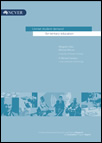Description
This report investigates factors that influence the decision-making process of applicants and the outcomes of post-school applications using the 2001 Survey of Education, Training and Information Technology. It finds that inability to obtain any place at a university or vocational education and training institute in 2001 was very low, but considerably higher in terms of getting a place in a preferred course at a preferred institution. The report adds to the understanding of what is known about the prevalence and causes of unmet student demand for tertiary education, a sensitive issue which is often not well understood.
Summary
About the research
Unmet demand for tertiary education is difficult to define and to estimate. In this report, data from the Australian Bureau of Statistics 2001 Survey of Education, Training and Information Technology are used to shed light on defining and enumerating unmet demand.
- Unmet demand occurs when potential students apply for a place at university or in the vocational education and training (VET) sector and their application is unsuccessful. It also occurs when potential students are discouraged from applying because their preferred course was not available, had limited places or was perceived to be highly competitive.
- The report finds that unmet demand at a general level (ability to obtain any place) in 2001 was very low at 16 000 or 1% of total applications, but considerably higher in terms of getting a place in a preferred course at a preferred institution (10% of total applications, or 175 000).
- A potential difficulty with these figures could be that they are understated. This is based on the widely acknowledged understanding that some individuals are not applying for courses because they assume that their applications will be unsuccessful. However, the data do not support that this is the case. That is, the estimates of unmet demand noted above are not understated.
Executive summary
This project examined student demand for post-school courses in terms of met and unmet demand. Community concern for applicants who fail to gain a place in their preferred courses has sparked debate regarding the extent of post-school education demand and the areas/sectors to which it applies. The particular research questions which form the focus of this project are:
- How has unmet demand been measured and analysed in previous studies?
- What is known about the prevalence and cause of unmet demand?
- What factors influence the decision to apply for post-school education?
- What factors influence the outcomes of post-school applications?
There is a lack of consensus in the literature over what constitutes total demand and its constituent parts, unmet and met demand.
Numerous narrow and broad definitions of unmet demand are available. A narrow definition applies to applicants who are unsuccessful in obtaining a place in their preferred field of study at their preferred institution. A broad definition applies to all persons who wanted to study and either did or didn’t apply, and who were not subsequently enrolled in a post-school course. In relation to this project report, it is important to choose a definition relevant to a policy context. Also important is how to estimate unmet demand so that policy initiatives designed to reduce it (assuming that this is the intention) can be evaluated.
One source of figures which could be used to estimate unmet demand is the 2001 Survey of Education, Training and Information Technology conducted by the Australian Bureau of Statistics (ABS). This database contains variables related to socio-demographic characteristics (such as age and gender), employment characteristics (such as occupation and labour force status), prior education (such as highest level of educational attainment), access to and use of education and training opportunities (such as current post-school study), and access to and use of information technology (such as computer ownership and internet access at home). Importantly, there is sufficient information to attempt a broad estimate of demand, both met and unmet, for post-school education in Australia in 2001. Hence, unmet demand is between 1% and 10% of total demand, or between 16 000 and 175 000 individuals. The range accommodates narrow and broad definitions of unmet demand.
The availability of the 2001 Survey of Education, Training and Information Technology also enables an examination of predictors of application submission and application failure. In terms of characteristics of applicants, it appears that the probability of applying for post-school education decreases with age. Moreover, people without Year 12 completions, with children and/or with a disability are less likely to apply. People with a computer at home, born overseas, not married, not working and/or have incomes below the median income are more likely to apply.
In terms of characteristics of unsuccessful applicants, those aged 20 to 24 years and/or those with a computer at home are less likely to have unsuccessful applications. Applicants aged 35 to 44 years, without Year 12 completion and/or with a disability are more likely to have failed applications.
Concerns that some of the characteristics of people applying for post-school courses may also be contributing to the success or failure of these applications appear to be unfounded; that is, estimates of unmet demand based on applicants alone are not biased or understated.
One of the key limitations of using the 2001 Survey of Education, Training and Information Technology for deriving these predictors is the absence of a variable for ability, or a prerequisite variable such as a tertiary entrance score. Such a variable is likely to be an important determinant of both application submission and application failure.
Notwithstanding, policy-makers concerned with the extent of unmet demand should be aware of the cost and supply constraints and their influence on total demand. Without a clear idea of total demand, the relative size of unmet demand remains imprecise.
